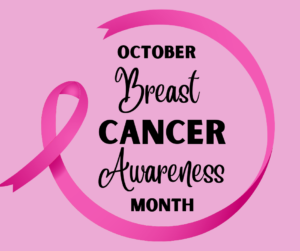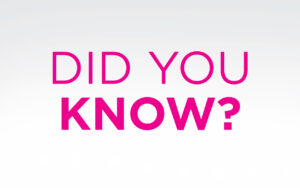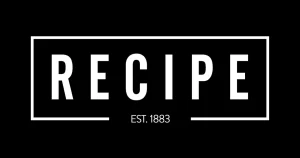

We added the September and October Health & Wellness Newsletter together!

October is Breast Cancer Awareness Month, an annual campaign to
raise awareness about the impact of breast cancer.
Myth: Finding a lump in your breast means you have breast cancer
Here’s The Truth
Only a small percentage of breast lumps turn out to be cancer. But if you discover a persistent lump in your breast that is new or notice any changes in breast tissue, it should never be ignored. It is very important that you see a physician for a clinical breast exam. He or she may possibly order breast imaging studies to determine if this lump is of concern or not.
Take charge of your health by performing routine breast self-exams, establishing ongoing communication with your doctor, getting an annual clinical breast exam, and scheduling your routine screening mammograms.
Myth: Men do not get breast cancer; it affects women only
Here’s The Truth
Quite the contrary, each year it is estimated that approximately 2,190 men will be diagnosed with breast cancer and 410 will die. While this percentage is still small, men should also check themselves periodically by doing a breast self-exam while in the shower and reporting any changes to their physicians.
Breast cancer in men is usually detected as a hard lump underneath the nipple and areola. Men carry a higher mortality than women do, by 25%, primarily because awareness among men is less and they are less likely to assume a lump is breast cancer, which can cause a delay in seeking treatment.
Myth: A mammogram can cause breast cancer or spread it
Here’s The Truth
A mammogram, or x-ray of the breast, currently remains the gold standard for the early detection of breast cancer. Breast compression while getting a mammogram cannot cause cancer nor does it spread it.
According to the National Cancer Institute, “The benefits of mammography, however, nearly always outweigh the potential harm from the radiation exposure. Mammograms require very small doses of radiation. The risk of harm from this radiation exposure is extremely low.”
The standard recommendation is an annual mammographic screening for women beginning at age 40. Base your decision on your physician’s recommendation and be sure to discuss any remaining questions or concerns you may have with your physician.
The National Breast Cancer Foundation provides free mammograms through our partner facilities via our National Mammography Program. Search for a partner facility and schedule a free mammogram today.
Myth: If you have a family history of breast cancer, you are likely to develop breast cancer, too
Here’s The Truth
While women who have a family history of breast cancer are in a higher risk group, most women who have breast cancer have no family history. Statistically only about 10% of individuals diagnosed with breast cancer have a family history of this disease.
- If you have a first degree relative with breast cancer: If you have a mother, daughter, or sister who developed breast cancer below the age of 50, you should consider some form of breast imaging starting 10 years before the age of your relative’s diagnosis.
- If you have a second degree relative with breast cancer: If you have had a grandmother or aunt who was diagnosed with breast cancer, your risk increases slightly, but it is not in the same risk category as those who have a first degree relative with breast cancer.
- If you have multiple generations diagnosed with breast cancer on the same side of the family, or if there are several individuals who are first degree relatives to one another, or several family members diagnosed under age 50, the probability increases that there is a breast cancer gene contributing to the cause of this familial history.
If this is your case, doctors recommend getting tested for breast cancer gene mutations such as the BRCA gene.
Myth: Breast cancer is contagious
Here’s The Truth
You cannot catch breast cancer or transfer it to someone else’s body. Breast cancer is the result of uncontrolled cell growth of mutated cells that begin to spread into other tissues within the breast. However, you can reduce your risk by practicing a healthy lifestyle, being aware of the risk factors, and following an early detection plan so that you will be diagnosed early if breast cancer were to occur.
Myth: If the gene mutation BRCA1 or BRCA2 is detected in your DNA, you will definitely develop breast cancer
Here’s The Truth
According to the National Cancer Institute, regarding families who are known to carry BRCA1 or BRCA2, “not every woman in such families carries a harmful BRCA1 or BRCA2 mutation, and not every cancer in such families is linked to a harmful mutation in one of these genes. Furthermore, not every woman who has a harmful BRCA1 or BRCA2 mutation will develop breast and/or ovarian cancer, but a woman who has inherited a harmful mutation in BRCA1 or BRCA2 is about five times more likely to develop breast cancer than a woman who does not have such a mutation.”
For people who discover they have the harmful mutation, there are various proactive measures that can be done to reduce risk. These include taking a hormonal therapy called Tamoxifen or deciding to take a surgical prevention approach which is to have bilateral prophylactic mastectomies, usually done with reconstruction. Most women will also have ovaries and fallopian tubes removed as well since there is no reliable screening test for the early stages of developing ovarian cancer.
Myth: Antiperspirants and deodorants cause breast cancer
Here’s The Truth
Researchers at the National Cancer Institute (NCI) are not aware of any conclusive evidence linking the use of underarm antiperspirants or deodorants and the subsequent development of breast cancer.
 Want to encourage
Want to encourage
someone else on their journey?
Leave a hope-filled message
on the Wall of Support.
Wall of Support
Hope-filled messages to survivors.
We are so much stronger together.

What’s the Deal with Cholesterol?
Did you know nearly 94 million U.S. adults have high cholesterol levels? High cholesterol increases your chances of contracting heart disease or having a stroke. But it’s never too late to improve your levels! Here are 4 facts you should know.
Fact #1: High cholesterol can have no symptoms.
Many people don’t know their cholesterol is too high. So talk to your doctor about checking your cholesterol levels.
Fact #2: Not all cholesterol is bad.
High levels of HDL (high-density lipoprotein) cholesterol can lower your risk for heart disease and stroke.
Fact #3: Healthy living can help improve cholesterol levels.
Healthy food choices, an active lifestyle, and avoiding tobacco products can all help keep your cholesterol in a healthy range.
Fact #4: Children can experience high cholesterol, too.
Children can have high cholesterol levels, just like adults. This is particularly true for children who inherit it from one or both parents.
Learn more about cholesterol and what you can do to help keep it under control.
Understanding Your Cholesterol Levels & How To Keep Them In Check
If you’re like most people, you probably don’t give much thought to your cholesterol levels. But with high cholesterol being a major risk factor for heart disease and stroke, it’s something everyone should think about. Fortunately, there are steps you can take that could help keep your cholesterol levels in check.
Let’s take a look at what cholesterol is, what the different types of cholesterol mean and what you can do to help cholesterol levels stay within a healthy range.
What is Cholesterol?
Cholesterol is a waxy substance that is found in all cells of the body. It is necessary for the body to function properly, but too much cholesterol can lead to serious health problems
There are two main types of cholesterol:
Low-density lipoprotein (LDL) cholesterol. This is the “bad” cholesterol that can build up on the walls of your arteries and cause blockages.
High-density lipoprotein (HDL) cholesterol. This is the “good” cholesterol that helps remove LDL.
What Causes High Cholesterol?
There are a variety of things that can cause high cholesterol, including eating too much unhealthy food, not getting enough exercise, smoking and drinking too much alcohol. Genetics may also play a role in high cholesterol levels. If you have high cholesterol, it’s important to make lifestyle changes and see a doctor to find out what treatments are available to help lower your cholesterol levels.
What are High Cholesterol Symptoms?
There are generally no signs of high cholesterol. This is why it is important to have your cholesterol levels checked regularly. So, what are health issues that occur from high cholesterol? If a person has very high cholesterol and lets it go unchecked, it can put them at an increased risk of heart attack or stroke.
Symptoms of these conditions include:
- Chest pain or tightness
- Shortness of breath
- Numbness or weakness in the arms or legs
- Paralysis
- Problems with vision or speech
Getting Your Cholesterol Levels Checked & Understanding Them
If you are looking to get your cholesterol levels checked, there are a few ways to do so. You can go to your doctor and have a blood test, or you can use a home cholesterol test kit. Your cholesterol levels can give you an idea of your risk for heart disease.
You want to have a lower LDL level and a higher HDL level. An optimal LDL level is around 100 mg/dL. A desirable HDL level is greater than or equal to 40 mg/dL in men and 50 mg/dL in women.
Your total cholesterol level is the sum of your LDL and HDL levels. A desirable total cholesterol level is less than 200 mg/dL.
If you have a family history of heart disease, you may want to get your cholesterol levels checked more often. You might also need to get your cholesterol levels checked more often if you have diabetes, high blood pressure or if you are a smoker.
There aren’t any high cholesterol symptoms, so you may not know if your cholesterol levels are too high. That’s why it’s important to get your cholesterol checked regularly.
How to Keep Your Cholesterol Levels in Check
There are a number of things you can do to keep your cholesterol levels in check, including:
Eating a healthy diet: Eating a balanced diet that includes plenty of fruits, vegetables, and whole grains can help to keep your cholesterol levels in check. Foods to avoid with high cholesterol include red meat, full-fat dairy products and processed foods.
Getting regular exercise: Exercise can help to improve your cholesterol levels by increasing your HDL cholesterol levels and helping you to lose weight.
Quitting smoking: Smoking is a major risk factor for high cholesterol. If you smoke, quitting is one of the best things you can do for your health.
See your doctor: If you have high cholesterol, it’s important to see your doctor and find out what treatment options are available to you. Treatment options may include lifestyle changes, medication or surgery.
Treatment Options for High Cholesterol
There are many different ways to treat high cholesterol. Some people may be able to lower their cholesterol by making lifestyle changes, such as diet and exercise. Others may need to take medication.
Your doctor can help you create a treatment plan that’s right for you. If you have high cholesterol, you may need to:
- Eat a heart-healthy diet
- Exercise regularly
- Take cholesterol-lowering medication
- Have your cholesterol checked regularly
If you have high cholesterol, you’re not alone. According to the Centers for Disease Control and Prevention (CDC), over one-third of American adults have high cholesterol. High cholesterol is a major risk factor for heart disease, stroke and other serious health conditions. But there’s good news: high cholesterol can be treated.
Know Your Numbers to Treat & Prevent Cholesterol
High cholesterol can be a serious health problem. It’s important to know your cholesterol levels and what you can do to treat and prevent high cholesterol. Hopefully, this information on what causes high cholesterol, the different cholesterol levels, and treatment options for high cholesterol helps you take steps to treat and prevent high cholesterol. Find a doctor near you to schedule an appointment to get tested!

Steakhouse Salad

Ingredients
• 10 ounces (4 to 5 small) red potatoes, quartered
• 2 tablespoons canola oil, divided
• 1 teaspoon black pepper, divided
• 1/2 teaspoon kosher salt, divided
• 1 (8-oz.) beef tenderloin filet
• 8 ounces cremini mushrooms, quartered
• 3 garlic cloves, chopped (about 1 1/2 Tbsp.)
• 1 tablespoon lower-sodium Worcestershire sauce
• 2 cups cherry tomatoes
• 1/3 cup low-fat buttermilk
• 1 tablespoon apple cider vinegar
• 3 ounces blue cheese, crumbled (about 3/4 cup), divided
• 8 cups fresh baby spinach (about 6 oz.)
Instructions
1. Preheat oven to 400°F. Toss potatoes with 1 tablespoon of the oil and 1/4 teaspoon each of the pepper and salt on a rimmed baking sheet. Roast potatoes until golden and tender, about 20 minutes, stirring halfway through baking.
2. Meanwhile, heat remaining 1 tablespoon oil in a heavy skillet over medium-high. Sprinkle beef with 1/4 teaspoon of the pepper and remaining 1/4 teaspoon salt. Sear beef until browned on all sides and a thermometer registers 130°F to 135°F (for medium-rare), about 3 minutes per side, or to desired degree of doneness. Transfer beef to a plate; let rest 5 minutes before slicing.
3. Return skillet to medium-high. Add mushrooms and garlic, and cook, stirring often, until browned, 2 to 3 minutes. Stir in 2 tablespoons water and Worcestershire, and cook 1 minute. Remove mushroom mixture. Add tomatoes to skillet; cook, stirring occasionally, until blistered, about 4 minutes. Remove from heat.
4. Stir together buttermilk, vinegar, 1/2 cup of the blue cheese, and remaining 1/2 teaspoon pepper in a large bowl. Toss spinach in buttermilk mixture.
5. Serve spinach topped with potatoes, beef, mushroom mixture, and tomatoes; sprinkle with remaining 1/4 cup blue cheese.
Prep Time: 25 minutes
Cook Time: 25 minutes
Servings: 4


